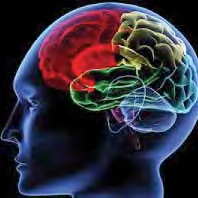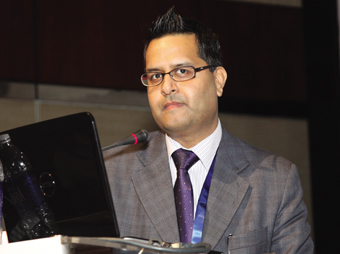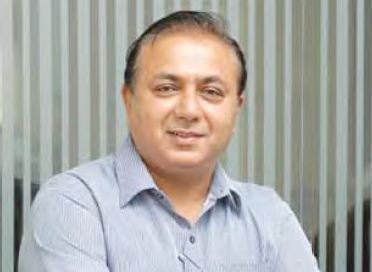
Dr Sunil Sanghi, Senior Consultant Dermatology and Medical Director,HealthFore

As India aspires to deliver effective, safe and affordable healthcare to its citizens, new innovations are getting pursued with enthusiasm, one of these innovations is mHealth
Mobile Health, or mHealth, can be broadly defined as the delivery of healthcare services via mobile elecommunication, including cell phone, PDAs, tablets and wireless infrastructure in general. With limited resources and huge healthcare gap in India, most of the population living in remote rural areas along with explosive growth of mobile communication with 900 million Indian having access to some form of mobile connection, mHealth has a potential to overcome healthcare challenges around access, cost and quality. From text messages disseminating information on health lifestyle to use of smart phones as medical devices capable of diagnosis and remote monitoring, mobile technologies in the future will permeate every aspect of health system.
Applications
The healthcare market is making significant investments in mHealth, the mobile technology is helping patients with chronic disease management. It is leading to improvement in quality of life for aging population, reminding patients to take medicine on time, extending services to remote areas and improving medical system efficiency.

There are more than 500 mHealth projects operating globally, more than 50 in India. WHO carried out a global survey in 2009 in 114 member states and majority of member states (83 percent) reported offering at least one type of mHealth service. Another interesting fact to emerge from the survey is that while emerging markets perceive mHealth as a way of increasing access to healthcare, in developed markets it is a way to improving convenience and cost factor. India is ranked second among of developing countries in its maturity for mHealth adoption according to June 2012 report by PWC. Some of the key mHealth applications in India include health call centres, emergency helpline, remote monitoring and reproductive healthcare.
Health hot lines (Medical call centre) – Technology such as mobile communication and call centre adopted for healthcare services delivery, allows providers to overcome the imbalance of resources and provide quality access to people in remote area. Mobile network operators provide the face for the health hot line and rely on third party provider. This system is good for triage and preventative services.
Remote monitoring (Tele home care) – The disease pattern across the globe is changing from communicable diseases to non-communicable or lifestyle disorders like diabetes, hypertension and COPD. India faces burden from both. Remote monitoring is ideally suited in these conditions and numbers of parameters which can be monitored are growing daily. There are devices that monitor vital signs associated with the diabetes, heart condition and COPD. Significant benefits have been reported globally in chronic heart failure, COPD and diabetes leading to significant reduction in hospital admission and improving quality of life. mHealth can help with improving quality of life for aging population while reducing the cost. The mobile enabled care giver systems can provide independence for the
elderly and empowering them with their own care. Elder care
| The four most frequently reported health applications are: Health call centres (59 percent) Emergency toll free telephone services (55 percent) Managing emergency and disasters (54 percent) Mobile telemedicine (49 percent) |
Mobile technologies in the future will permeate every aspect of health system
devices to detect fall, track behavioural changes and locate Alzheimers patients are available in market.
Emergency helpline – Quick access to trained healthcare workers to provide first aid and directions in emergencies, such as road traffic accidents, are saving lives. Some of the innovative concepts are coming in this field such as stroke helpline where saving time is saving brain and proving to be as successful as a standalone model.
Reproductive healthcare– mHealth is filling the gap of skilled personnel by guiding and training, increasing flow of information via SMS campaigns in various stages of pregnancy, guiding patients towards institutional delivery leading to significant reduction in maternal mortality.
Barrier
Apart from health call centre, emergency helpline, most mHealth applications are in pilot stages. Despite showing promising results during pilot, many projects are abandoned after pilot stages, largely because they lack sustainable business model. Despite demand and obvious potential benefits, rapid adoption is not occurring; the key to success lies in the interoperability between key stakeholders of mHealth, technology, finance, healthcare workers and government.
Careful thought needs to be put about how to create incentives that encourage range of stakeholders to engage. For example, with current payment structure where remuneration is based on number of nights, the patients spend in hospital, there is little incentive for remote monitoring and treatment. mHealth will be effective if it is easy to use, cost effective and tightly integrated with existing healthcare professional work flow.
Conclusion
In India taking healthcare to the underserved is a particular challenge. As government looks to lay a foundation for more equitable society, healthcare delivery is a critical challenge, one that mHealth is well suited to address. Mobile health is no more an optional choice, a fantastic challenge and a must for a vast country like India. One of the undesirable consequences of modern healthcare has been loss of communication and growing distance between doctors and patients. mHealth can be one of the tools to bridge this gap.
Be a part of Elets Collaborative Initiatives. Join Us for Upcoming Events and explore business opportunities. Like us on Facebook , connect with us on LinkedIn and follow us on Twitter , Instagram.













